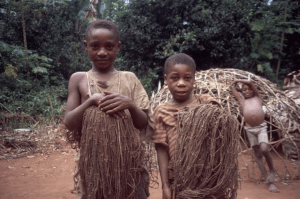Unlike the children worldwide, the hunter-gatherer children in the Congo Basin didn’t sit in classroom setups and follow structured curriculums, or rely on textbooks. Instead, they learned through immersion in their communities, observation of adults, and hands-on participation in daily life. A recent study by Washington State University shows a fascinating glimpse into this thousands of years of learning process, shedding light on how children thrived in hunter-gatherer groups without formal education.
The study led by Barry S. Hewlett, dives deep into the ways ancient societies fostered learning, emphasizing the role of observation, play, and communal engagement. Researchers investigated hunter-gatherer societies to understand how children learned essential survival skills. The researchers formed 25 to 35 people in small camps and living in homes that were a few feet far from each other. From foraging and crafting to social cooperation, these communities relied on a learning model. It was both adaptive and deeply embedded in the natural environment.
By examining these practices, the study not only helps us appreciate the ingenuity of ancient learning methods but also challenges us to rethink how modern education could integrate some of these time-tested principles.
Key Insights from How Hunter-gatherer Children Learned Human History
The Washington State University study sheds light on the stark contrast between ancient and modern learning methods. Researchers argue that the children in the hunter-gatherer from Congo Basin acquired knowledge in informal settings, learning by engaging directly with their adults, communities, and across a wide range of natural environments in Africa. These children often learned how to hunt, identify edible plants, and care for babies by the tender age of six or seven.
“We focus on hunter-gatherers because this way of life characterized 99% of human history,” said Barry Hewlett, a professor of anthropology at WSU and lead author of the study.

The study highlights the importance of social equality. Children in the hunter-gatherer groups learn the importance of respecting individuals’ autonomy by observing the behavior of adults and children around them. They are never forced to learn. Instead, they are given the freedom to explore and self-practice skills, enabling them to gain a deep understanding of ancient human cultures.
The researchers used observational and ethnographic data to find nine different modes of cultural transmission such as from whom and how children learn, in hunter-gatherer societies of Africa.
Key takeaways from the study include:
- Observational Skills
Children from the hunter-gatherer group spend a lot of time in multi-aged groups. Observational research with Martu of Australia and Hadza of Tanzania revealed that these children went to find edible plants, fruits, nuts, and seeds, and to hunt small animals without adults but learned from older children and adolescents. - Learning Through Play
The study highlights the integral role of play in children’s development. Activities like pretend hunting or group games mirrored adult responsibilities, allowing children to hone physical, cognitive, and social skills in a low-risk environment.
“This approach to learning contributes to the ability to build on existing knowledge and pass it down through generations which is called ‘cumulative culture’,” Hewlett said.
Ancient Learning Process in Hunter-Gatherer Children
- No Distinction Between Work and Play: Children seamlessly transitioned between observing adult tasks, imitating them, and engaging in play that reinforced those tasks.
- Learning at Their Own Pace: There was no pressure to master skills within a set timeframe. Children’s curiosity and interests naturally guided their learning.
- Practical Knowledge Over Abstract Concepts: Learning focused on real-world applications, such as tracking animals, identifying edible plants, and navigating landscapes.
Hewlett hopes this research offers a deeper understanding of the “nature of social learning” in humans and how cultures are protected and change over time.

